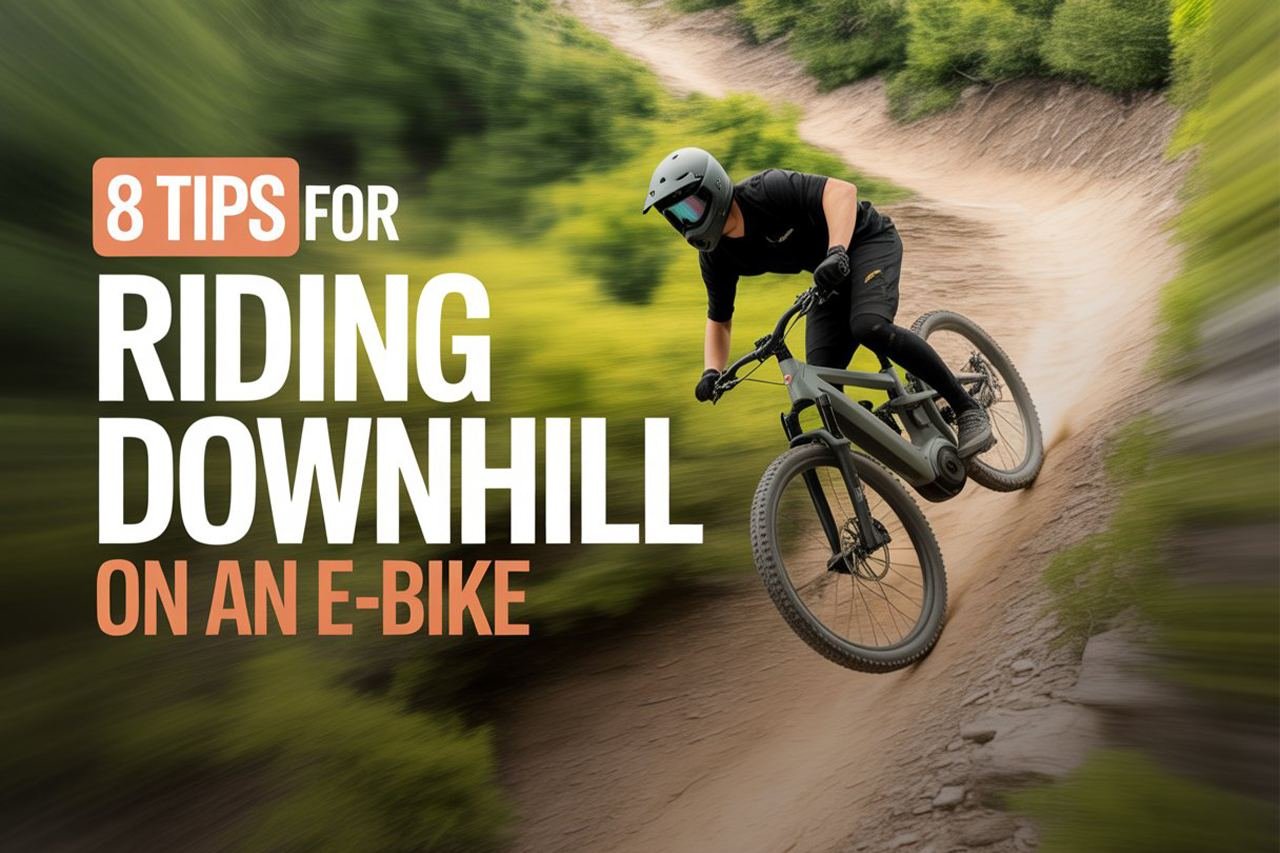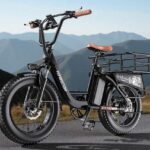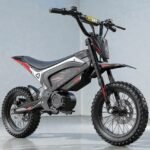
Recently got an electric bike and wondering how to handle the descents with grace and ease? Even a cycling pro can find the downward journeys a little tricky at times; you’re not alone if you find yourself losing your balance, veering a little, and struggling to control your speed. That’s why we’ve collated these top tips!
There are lots of things that make it easier to ride downhill smoothly, including managing your weight distribution with care, keeping your eyes ahead, keeping your speed down, maintaining contact with the bike, and using the motor responsibly. It’s also important to take breaks when necessary.
Implementing these tips will ensure that your rides go safely and smoothly, and will maximize your enjoyment of the descent. Riding downhill can be great, but it needs to feel safe and comfortable for you. With that in mind, let’s dig into this and find out what’s what!
Tip 1) Managing Your Weight Distribution
Being balanced on your e-bike when you’re descending a hill is fundamental to feeling steady and comfortable. If you’re sitting awkwardly or your weight is poorly distributed across the bike, there’s a much higher chance that you’ll fall off or that you will feel uncomfortable throughout the descent.
You instead want to ensure that your back is almost parallel to the ground and your knees and elbows are bent at approximately equal angles. This will help to evenly distribute your weight and ensure you are balanced.
A lot of riders lean into their hands, but this isn’t great for a number of reasons. Firstly, it will make your arms and hands tired, which reduces your control and makes it harder to ride for long periods.
Secondly, it stops your e-bike from tracking as well on the terrain. Instead, you want to put your weight into your feet as much as possible. This will improve your balance and the tracking.
You may find it helps to watch some videos of riders going downhill to get an idea of the position you want to assume. This can make it easier to figure out how to sit on a bike, and may increase your confidence too.
Tip 2) Keeping Your Eyes Ahead
A lot of riders who are nervous about going downhill watch the ground under their feet, or just in front of their wheels. That might feel like it’s keeping you safer, but it’s massively inhibiting your ability to plan and adjust for the environment, and it’s pretty dangerous.
Instead, your eyes should be up and focused on the road ahead. Plan your route, watch for obstacles, and make adjustments early so you don’t have to swerve sharply. Remind yourself to keep your gaze up as you go!
Tip 3) Keeping Your Speed Down
It’s very easy to end up descending hills fast, and some riders even think that they need to in order to make the most of the hill. However, doing so is a recipe for disaster. It will reduce your control and make you far more likely to have an accident – and possibly a bad one.
This will reduce your confidence and make it harder to tackle hills effectively in the future, so it needs to be avoided. You should therefore start out slowly on the hills, making sure you use your brakes gently, and keeping your movement at a pace that feels comfortable to you.
Whenever you use your brakes, remember to squeeze them gently, rather than harshly. It’s easy to end up braking too sharply when you’re traveling at speed, and this is both dangerous and bad for the bike. It will also leave you feeling sorer at the end of the ride, because of all the jolting. Overall, aim to keep your speed down by using the e-bike’s controls, and brake gently and infrequently where possible.
Slow descents are usually the best, even for expert riders. Whenever you start going downhill, ease into it. Remember, you can always speed up later, once your confidence has risen and you’ve got a feel for the slope and the terrain you’re handling!
Tip 4) Maintaining Contact With The Bike
Some riders approach hills by trying to lift themselves up from the bike and minimize contact – but that’s the opposite of the approach you want to take. It destabilizes you and reduces your control, and can make it more difficult to anticipate any bumps in the terrain.
Instead, you should maximize the contact between your body and the bike. Keep your hands firmly on the handlebars, your feet firmly on the pedals, and your backside firmly on the seat. This will give you increased stability and a greater sense of control, improving your confidence and your ability to deal with terrain changes.
It also means that if you do need to change speed or swerve, you’re less likely to lose your balance. E-bikes are heavier than standard bikes, and it often takes time to adjust to this fact, so maximize your control by keeping your body in close contact with the bike when going down a hill.
Tip 5) Using The Motor Responsibly
Is it tempting to use the motor on a hill and send yourself flying down as fast as possible? Once you’re an expert on your e-bike, it might well be! However, you shouldn’t do this.
Although the speed of e-bikes is certainly one of their attractions and even expert riders get carried away at times, it’s important to remain aware of how fast you are going, and to maintain a safe speed, even on a steep descent. This will minimize the risk of accidents and help you feel more comfortable.
This tip is also important when it comes to avoiding surprises on the trail, and works in tandem with the one about always looking ahead. If you are going too fast, you won’t have time to spot upcoming obstacles and react to them.
The amount of thinking and reaction time you have before having to address something you’ve seen coming can help you determine whether your speed is about right, or whether you need to slow down a bit for the sake of safety.
Tip 6) Taking Breaks
You don’t have to do the entire hill in one go, especially if it’s a long one and you’re nervous about the descent. It’s absolutely fine to pull your bike over to the side and take a break, and doing so may make you safer for the rest of the descent.
Pausing for just a few minutes is often enough to let both your brain and your muscles take a break and refresh. This will improve your balance, your control, and your posture on the bike. It can also help prevent stiffness and soreness at the end of the ride, because you will have let your muscles move around and relax a few times.
Many cyclists hesitate to take a break, but remember that there’s nothing wrong with doing so as long as there’s a safe space to stop. Just because you’re riding an e-bike doesn’t mean that you have to do the whole run without a pause!
Tip 7) Remain Relaxed
Even if you’re an expert rider, you may find that you sometimes tense up during those long descents, particularly if it’s an unfamiliar environment. If you realize you’re hunching over the handlebars and coiling all the tension up in your muscles, it’s important to take a few moments to loosen up.
Consciously untense your body and let your muscles relax. Take a few deep breaths before resuming the descent. This will help oxygenate your blood, making it easier to think clearly, and should help you to feel calmer and more relaxed. You can do this as many times as you need to during a ride!
Tip 8) Pay Attention To Weather
It’s very easy to forget about the effect weather conditions have on a bike’s handling, especially if you’re not used to riding in rainy or frosty environments. This happens to many beginners, but it can also be an issue for pros, who may be more likely to suffer from over-confidence issues.
It’s always important to assess the weather and the trail’s conditions when you start a descent. Is it wet and slippery? Is it likely to be icy? If so, you’re going to need to take a much slower approach, and recognize that your stopping power is greatly reduced.
You should also think about things like visibility. If you’re operating in misty conditions or driving rain, you’re not going to have such good visibility, and that makes it harder to plan ahead. Make sure you account for this whenever you’re going downhill in poor weather!
Conclusion
Using these tips should help you to feel more confident and safer whenever you’re going downhill on an e-bike, and even experts can benefit from taking the time to review whether their form is right and where they could improve. Don’t feel you have to rush or show off; take things at your own pace, and you’ll have a safer, more enjoyable ride.
Useful Links
- Discover new techniques for faster and safer descents.
- COAST BIKE CO. has a fantastic guide: Top Tips for Going Downhill Safely.
- Expand your knowledge on riding skills with Bicycling’s guide.




![How to Reset Your Electric Bike Battery: A Complete Guide ([year]) How to Reset Electric Bike Battery?](https://goebikelife.com/wp-content/uploads/2025/05/How-to-Reset-Electric-Bike-Battery-768x512.jpg)



